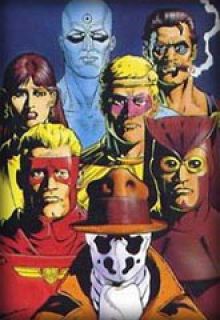
Watchmen
A DC Comics team.
Watchmen's History
In October 1985, Walter Kovacs (Rorschach) investigates the murder of New Yorker Edward Blake and discovers that Blake was the "Comedian," a veteran costumed adventurer and government agent. Forming a theory that Blake's murder is part of a greater plot to eliminate costumed adventurers (or "masks," as Rorschach calls them), Kovacs warns others: Jon Osterman (Dr. Manhattan), Laurel Jane Juspeczyk (the second Silk Spectre), Daniel Dreiberg (the second Nite Owl) and Adrian Veidt (Ozymandias). Veidt, Juspeczyk and Dreiberg are long retired from crime-fighting, the latter two because of the 1977 passage of the Keene Act, which had banned costumed vigilantes (a law that Kovacs, deeply immersed in his Rorschach identity and uncompromising moral code, ignores). Veidt retired voluntarily in 1975, disclosing his identity publicly and using his reputation and intelligence to build a successful commercial enterprise and a large personal fortune. Like Blake, Osterman remained exempt from the Keene Act as an agent of the U.S. government. He no longer engages in crime fighting, having become an important element of the ongoing Cold War.The United States and the Soviet Union have been edging toward a nuclear showdown since the 1959 nuclear accident that transformed Osterman into the super-powered Dr. Manhattan. Due to Osterman's near-godlike powers and allegiance to the American government, the U.S. has enjoyed a distinct strategic advantage, allowing it to defeat the Soviet Union in a series of proxy wars, including victory in Vietnam. Richard Nixon used this success and, unmarred by the Watergate scandal which attracted little or no attention, encouraged a repeal of the 22nd Amendment, removing Presidential term limits. He remains President in 1985, on an unprecedented fifth term of office.
This imbalance of power accelerated the nuclear arms race and dramatically increased global tension. In seeming anticipation of global war, American society has assumed a general sense of fatalism about the future. Signs of this in daily life range from "Meltdowns" candy to graffiti inspired by the Hiroshima bombing to the designation of many buildings in New York as fallout shelters.
Veidt, observing Osterman's increasing emotional detachment from humanity, forms a theory that military expenditures and environmental damage will lead to global catastrophe no later than the mid-1990s. As part of an elaborate plot to avert this, Veidt acts to accelerate Osterman's isolation by secretly exposing more than two dozen of Osterman's former associates to harmful radiation, inflicting a variety of cancers on them. Meanwhile, Veidt manipulates the press into speculating that Osterman himself was the cause of these cancers.
Now hounded by media allegations and quarantined as a result, Osterman teleports himself to the planet Mars to contemplate the events of his life. His break with the U.S. government prompts Soviet opportunism in the form of an invasion of Afghanistan (a delayed version of the real-life event), greatly aggravating the global crisis and prompting Nixon to consider nuclear options.
Investigating the calamities that have befallen other heroes, Dreiberg and Kovacs discover information incriminating Veidt; Kovacs, Juspeczyk, Osterman and Dreiberg confront Veidt at his Antarctic retreat, but too late to prevent the final phase of his plan (which was, according to Moore, coincidentally similar to an episode of The Outer Limits; a nod to the episode is made near the end when Laurie and Dreiberg stop by to visit her mother [1]). Using a teleportation device, Veidt moves a massive, genetically-engineered, psionic creature into the heart of New York City, knowing that the teleportation process will kill it. In its death-throes, the creature releases a "psychic shockwave" containing imagery designed to be so violent and alien as to kill half the residents of the city and drive many survivors insane. With the world convinced that the creature is the first of a potential alien invasion force, the United States and Soviet Union withdraw from the brink of war and form an accord to face this apparent extraterrestrial threat.
The murderer of Blake is revealed to be Veidt himself, acting after Blake had accidentally discovered details of Veidt's plot. Veidt has also eliminated numerous employees and minions. At the end, the only people aware of the truth are Veidt, Dreiberg, Juspeczyk, Kovacs and Osterman. Dreiberg, Juspeczyk and Osterman agree to keep silent out of concern that revealing the plot could re-ignite U.S.-Soviet tensions, but Kovacs refuses to compromise and leaves to tell the world about Veidt's actions. Osterman attempts to dissuade Kovacs, but when Kovacs challenges Osterman to silence him through murder, Osterman does so with almost no hesitation.
The ending of Watchmen is deliberately ambiguous about the long-term success of Veidt's plan to lead the world to utopia. After killing Kovacs, Osterman talks briefly to Veidt. Professing his guilt and doubt, Veidt asks the precognitive Osterman for closure: "I did the right thing, didn't I? It all worked out in the end." Osterman, standing within Veidt's mechanical model of the solar system, replies cryptically: "In the end? Nothing ends, Adrian. Nothing ever ends." He then disappears, leaving Earth forever and leaving the entire orrery framed by a residue appearing distinctly similar to an atomic mushroom cloud.
However, before confronting Veidt, Kovacs had mailed his journal detailing his suspicions to The New Frontiersman, a far right-wing magazine he frequently read. The final frame of the series shows a New Frontiersman editor contemplating which item from the "crank file" (to which Kovacs's journal had been consigned) to use as filler for the upcoming issue. The final line of the story is that of the editor's superior, indifferent as to which piece from the crank file is selected. He tells his subordinate: "I leave it entirely in your hands."


